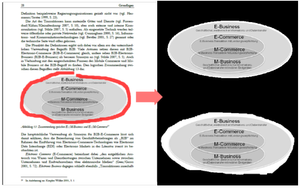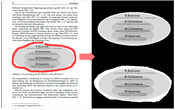Information
- Publication Type: Bachelor Thesis
- Workgroup(s)/Project(s):
- Date: 2016
- Date (Start): October 2015
- Date (End): July 2016
- Matrikelnummer: 1226287
- First Supervisor: Manuela Waldner
Abstract
Creating a free-form screen shot to get what is needed is not trivial task. Moving the mouse cursor around the desired region to indicate the boundary of the screen snippet often yields jagged outlines in the result image. Furthermore, it is not that easy to fully exclude unnecessary screen elements during the selection process. As a consequence, the created screen shot may also contain some small portions of surrounded image elements which are unwanted in the result image or some areas may be accidentally truncated. To overcome these limitations, Advanced Screen Capturing combines screen capture functionalities with image processing methods as an alternative way for creating free-form screen shots. The selection of the desired screen region is done by roughly selecting the needed image area. After extracting the highlighted screen region, a stroke mask is calculated for detecting the surrounded image elements by the drawn stroke. This stroke mask forms the basis for rejecting or accepting partly crossed image regions or truncating large ones. The image regions for accepting and rejection are detected as contours. By combining the stroke mask and the detected contours the segmentation mask is generated, where image regions are either fully included, fully rejected, or cut, depending on their amount of overlays with the stroke mask. Based on the segmentation mask, the original captured screen shot is segmented. In the end, the calculated result image contains all user defined relevant image information and adapted image boundaries. The introduced screen capture and contour-based segmentation algorithm works best for screen elements like text, charts, different kinds of shapes and a combination of these. Advanced Screen Capturing can be used as a library for integration purposes in other systems or as a stand alone desktop application. It was implemented by using C++ and Qt Framework and the OpenCV library.Additional Files and Images
Weblinks
No further information available.BibTeX
@bachelorsthesis{donabauer-2015-asc,
title = "Advanced Screen Capturing",
author = "Johanna Donabauer",
year = "2016",
abstract = "Creating a free-form screen shot to get what is needed is
not trivial task. Moving the mouse cursor around the desired
region to indicate the boundary of the screen snippet often
yields jagged outlines in the result image. Furthermore, it
is not that easy to fully exclude unnecessary screen
elements during the selection process. As a consequence, the
created screen shot may also contain some small portions of
surrounded image elements which are unwanted in the result
image or some areas may be accidentally truncated. To
overcome these limitations, Advanced Screen Capturing
combines screen capture functionalities with image
processing methods as an alternative way for creating
free-form screen shots. The selection of the desired screen
region is done by roughly selecting the needed image area.
After extracting the highlighted screen region, a stroke
mask is calculated for detecting the surrounded image
elements by the drawn stroke. This stroke mask forms the
basis for rejecting or accepting partly crossed image
regions or truncating large ones. The image regions for
accepting and rejection are detected as contours. By
combining the stroke mask and the detected contours the
segmentation mask is generated, where image regions are
either fully included, fully rejected, or cut, depending on
their amount of overlays with the stroke mask. Based on the
segmentation mask, the original captured screen shot is
segmented. In the end, the calculated result image contains
all user defined relevant image information and adapted
image boundaries. The introduced screen capture and
contour-based segmentation algorithm works best for screen
elements like text, charts, different kinds of shapes and a
combination of these. Advanced Screen Capturing can be used
as a library for integration purposes in other systems or as
a stand alone desktop application. It was implemented by
using C++ and Qt Framework and the OpenCV library.",
address = "Favoritenstrasse 9-11/E193-02, A-1040 Vienna, Austria",
school = "Institute of Computer Graphics and Algorithms, Vienna
University of Technology ",
URL = "https://www.cg.tuwien.ac.at/research/publications/2016/donabauer-2015-asc/",
}


